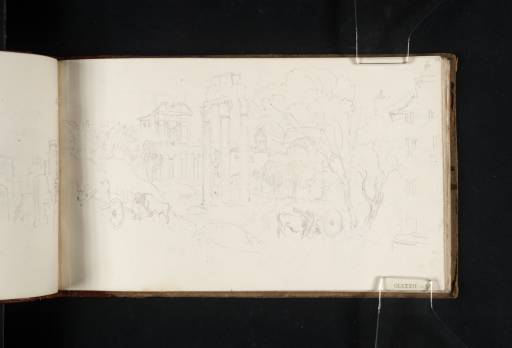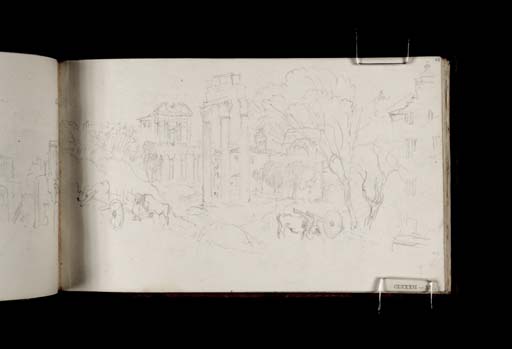Joseph Mallord William Turner The Forum, Rome, with the Temple of Castor and Pollux 1819
Image 1 of 2
Joseph Mallord William Turner,
The Forum, Rome, with the Temple of Castor and Pollux
1819
Joseph Mallord William Turner 1775–1851
Folio 53 Recto:
The Forum, Rome, with the Temple of Castor and Pollux 1819
D15395
Turner Bequest CLXXXII 52
Turner Bequest CLXXXII 52
Pencil on white wove paper, 113 x 189 mm
Inscribed by John Ruskin in blue ink ‘52’ top right and ‘301’ bottom right
Stamped in black ‘CLXXXII 52’ bottom right
Stamped in black ‘CLXXXII 52’ bottom right
Accepted by the nation as part of the Turner Bequest 1856
References
1909
A.J. Finberg, A Complete Inventory of the Drawings of the Turner Bequest, London 1909, vol.I, p.538, as ‘Campo Vaccino, with Temple of Faustina and San Lorenzo in Miranda in distance, with remains of the Temple of Castor near foreground’.
1984
Cecilia Powell, ‘Turner on Classic Ground: His Visits to Central and Southern Italy and Related Paintings and Drawings’, unpublished Ph.D thesis, Courtauld Institute of Art, University of London 1984, pp.116, 256 note 106.
1987
Cecilia Powell, Turner in the South: Rome, Naples, Florence, New Haven and London 1987, pp.[42] note 17, 125 note 65.
Turner’s sketchbooks reveal that he thoroughly explored the various monuments of the Roman Forum from a host of different angles. The central focus of this sketch is the remains of the Temple of Castor and Pollux, an ancient building dating from the fifth century BC of which only three Corinthian columns and a surmounting section of entablature from the first century AD remain. The most visible edifice beyond is the portico of the Temple of Antoninus and Faustina with the façade of San Lorenzo in Miranda rising above it. This Roman temple was first dedicated to Faustina, the wife of Emperor Antoninus Pius in the second century AD but was later converted into a church following the belief that St Lawrence had been condemned to death there. During the seventeenth century, the antique remains were incorporated within a newly designed Baroque exterior. Also visible is the adjacent Church of Santi Cosama e Damiano with the cupola of the Temple of Romulus and the end arch of the Basilica of Constantine. The composition of the view is similar to the one copied by Turner in the Italian Guide Book sketchbook after John ‘Warwick’ Smith, (see Tate D13966; Turner Bequest CLXXII 19). A related coloured study can be found in the Rome: C. Studies sketchbook (see Tate D16375; Turner Bequest CLXXXIX 46).
In the foreground of the sketch Turner has included some of the peasants’ ox-carts and cattle which littered the Roman Forum during the nineteenth century and lent the site its modern name of the Campo Vaccino (Field of Cows). Many tourists remarked on the ironic juxtaposition of common livestock with the decaying remains of former imperial power. For example, an American traveller, Nathaniel Hazeltine Carter, wrote in 1827:
The Forum is now called Il Campo Vaccino – an appellation so mean as scarcely to admit of a decent translation. But what is the vulgarity of its name (Anglice cow-yard), compared with the vile uses to which it is degraded? At the time of our first visit it was covered with carts, from which the teams of oxen were unharnessed and quietly ruminating as they reclined in pairs ... Can this be the Forum? Yea verily it is the Roman Forum; for beneath us, triumphal arches and porticoes and insulated columns, piercing the strata of rubbish heaped upon the old pavement to the depth of twenty or thirty feet, rear their Grecian capitals and shattered cornices above the scene of desolation, coming like tell-tale messengers from the world below.1
For a general discussion of the Forum see folio 32 (D15355).
Nicola Moorby
May 2008
How to cite
Nicola Moorby, ‘The Forum, Rome, with the Temple of Castor and Pollux 1819 by Joseph Mallord William Turner’, catalogue entry, May 2008, in David Blayney Brown (ed.), J.M.W. Turner: Sketchbooks, Drawings and Watercolours, Tate Research Publication, December 2012, https://www


